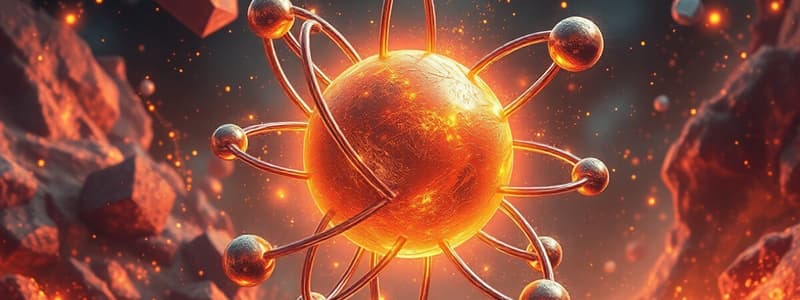Podcast
Questions and Answers
What is a significant characteristic of white cast iron?
What is a significant characteristic of white cast iron?
- Low brittleness
- High machinability
- High ductility
- Hard and wear resistant (correct)
Which ASTM standard is associated with abrasion-resistant cast iron?
Which ASTM standard is associated with abrasion-resistant cast iron?
- ASTM A48
- ASTM A532 (correct)
- ASTM A667
- ASTM A748
What is the main reason gray cast iron is commonly used in machine bases?
What is the main reason gray cast iron is commonly used in machine bases?
- Ability to absorb vibration (correct)
- Better aesthetics
- High tensile strength
- Excellent resistance to corrosion
What impacts the fluidity of gray iron during casting?
What impacts the fluidity of gray iron during casting?
Which of the following is NOT a type of white cast iron mentioned?
Which of the following is NOT a type of white cast iron mentioned?
What is the common element found in gray cast iron that contributes to its microstructure?
What is the common element found in gray cast iron that contributes to its microstructure?
At what temperature range is gray iron usually cast?
At what temperature range is gray iron usually cast?
What is a common application for gray cast iron?
What is a common application for gray cast iron?
What is the maximum manganese content in plain carbon steel designated as 10xx?
What is the maximum manganese content in plain carbon steel designated as 10xx?
Which alloy designation refers to re-phosphorized steel?
Which alloy designation refers to re-phosphorized steel?
What is the nominal molybdenum content range for 40xx steel?
What is the nominal molybdenum content range for 40xx steel?
Which alloy includes a maximum chromium content of 1.05?
Which alloy includes a maximum chromium content of 1.05?
What is the primary application for materials designated in the AMS system?
What is the primary application for materials designated in the AMS system?
Which designation corresponds to a steel alloy with manganese content of 1.75?
Which designation corresponds to a steel alloy with manganese content of 1.75?
What is the nominal chromium range for chromium-vanadium steel designated as 61xx?
What is the nominal chromium range for chromium-vanadium steel designated as 61xx?
What is the primary function of a ladle furnace in steel processing?
What is the primary function of a ladle furnace in steel processing?
How does vacuum tank degassing reduce dissolved gases in liquid steel?
How does vacuum tank degassing reduce dissolved gases in liquid steel?
What distinguishes VIM-VAR steels used in critical applications?
What distinguishes VIM-VAR steels used in critical applications?
What is the purpose of grinding the surfaces of electrodes in the vacuum arc remelting process?
What is the purpose of grinding the surfaces of electrodes in the vacuum arc remelting process?
What is achieved by employing a slag layer in ladle furnaces?
What is achieved by employing a slag layer in ladle furnaces?
Why are VIM-VAR steels particularly suited for military helicopter rotor shafts?
Why are VIM-VAR steels particularly suited for military helicopter rotor shafts?
What role does inert gas stirring play in the operation of ladle furnaces?
What role does inert gas stirring play in the operation of ladle furnaces?
What process follows the initial melting of steel in an electric arc furnace in the production of VIM-VAR steels?
What process follows the initial melting of steel in an electric arc furnace in the production of VIM-VAR steels?
What causes micro-laminations in powder metallurgy parts?
What causes micro-laminations in powder metallurgy parts?
Which of the following is NOT a method of nondestructive testing for powder metallurgy parts?
Which of the following is NOT a method of nondestructive testing for powder metallurgy parts?
What is the primary purpose of using Gamma-ray density testing in nondestructive evaluation?
What is the primary purpose of using Gamma-ray density testing in nondestructive evaluation?
How does thermoplastic behave when subjected to heat?
How does thermoplastic behave when subjected to heat?
Which issue might arise from improper sintering in powder metallurgy?
Which issue might arise from improper sintering in powder metallurgy?
Which historical figure is credited with the creation of the first man-made plastic?
Which historical figure is credited with the creation of the first man-made plastic?
What type of plastic retains its shape after being heated and reshaped?
What type of plastic retains its shape after being heated and reshaped?
What is the main diagnostic capability of electrical resistivity testing in powder metallurgy?
What is the main diagnostic capability of electrical resistivity testing in powder metallurgy?
What aspect of materials is critical for non-destructive testing (NDT)?
What aspect of materials is critical for non-destructive testing (NDT)?
Which historical figure first proposed the concept of the atom as indivisible?
Which historical figure first proposed the concept of the atom as indivisible?
What key concept discovered by JJ Thompson relates to the atomic structure?
What key concept discovered by JJ Thompson relates to the atomic structure?
What did Ernest Rutherford propose about the atom's structure?
What did Ernest Rutherford propose about the atom's structure?
How do magnetic particle inspection methods work regarding different metals?
How do magnetic particle inspection methods work regarding different metals?
Why is understanding atomic and subatomic levels important in NDT methods like radiography?
Why is understanding atomic and subatomic levels important in NDT methods like radiography?
What fundamental aspect of the atom did John Dalton contribute to the understanding of matter?
What fundamental aspect of the atom did John Dalton contribute to the understanding of matter?
Which of the following is NOT a reason for understanding the nature of materials in NDT?
Which of the following is NOT a reason for understanding the nature of materials in NDT?
Study Notes
Nature of Matter
- Understanding the properties of materials is important for Non-Destructive Testing (NDT)
- The term "atomos" was first coined by Democritus around 440 BC, meaning the smallest particle of matter.
- John Dalton proposed in 1803 that each atom has a characteristic mass that remains unchanged in chemical processes.
- JJ Thomson revealed through his work on cathode rays, that subatomic particles (electrons) existed.
- Ernest Rutherford proposed in 1908 that the mass of an atom is concentrated in the center (nucleus), with orbiting electrons.
Ferrous Metals
- White Cast Iron is hard and wear-resistant but brittle and difficult to machine. It is often alloyed for high abrasion resistance in mining, earthmoving, and heavy industries.
- It has three classes and four types.
- Gray Cast Iron is the most common type of cast iron and is sometimes called just "cast iron".
- Typical applications for gray cast iron include clutch plates and brake drums.
- The fluidity of gray cast iron is dependent on the carbon content; as carbon content decreases, fluidity also decreases.
Steels
- Carbon Steel is typically classified based on its manganese content, and alloy content is indicated by the 1xxx designation.
- Manganese Steel is indicated by 13xx and has a manganese content between 1.75%.
- Nickel Steel is indicated by 23xx and 25xx, with nickel content of 3.5% and 5% respectively.
- Nickel-Chromium Steel is indicated by 31xx, 32xx, 33xx, and 34xx.
- Molybdenum Steels are indicated by 40xx and 44xx, with molybdenum content of 0.20-0.25% and 0.40-0.52% respectively.
- Chromium-Molybdenum Steel is indicated by 41xx, 43xx, and 47xx.
- Chromium Steel is indicated by 50xx and 51xx.
- Chromium-Vanadium Steel is indicated by 61xx, with chromium and vanadium content of 0.60-0.95% and 0.10-0.15% respectively.
- Tungsten-Chromium Steel is indicated by 72xx, with tungsten and chromium content of 1.75% and 0.75% respectively.
- Nickel-Chromium-Molybdenum Steel is indicated by 81xx, 86xx, 87xx, and 88xx.
- Silicon-Manganese Steel is indicated by 92xx, with silicon and manganese content of 1.40-2.00% and 0.65-0.85% respectively.
- Nickel-Chromium-Molybdenum Steel is indicated by 93xx, 94xx, 97xx, and 98xx.
Steel Processes
- Ladle Furnace is used to reheat the liquid steel, provide uniform temperature and chemistry, remove metal oxides and sulfur, and desulfurize the steel.
- Vacuum Tank Degassing (VTD) is used to reduce dissolved gasses (hydrogen, nitrogen, and oxygen) in the liquid steel.
- Vacuum Induction Melting (VIM) and Vacuum Arc Remelting (VAR) are used for highly critical applications such as aerospace components.
Powder Metallurgy
- Micro-laminations develop as a result of microcracks during ejection from the pressing operation, which remain unhealed during sintering.
- Improper sintering is a result of insufficient time or temperature, improper furnace atmosphere, or inadequate removal of lubricant.
- NDE methods can be applied to powder metallurgy parts before and after sintering.
NDE of Powder Metallurgy Parts
- Gamma-ray density is used to identify density variations.
- Electrical Resistivity is used to measure density variations and degree of sintering.
- Eddy Current is used to measure density, hardness, and chemistry.
- Magnetic Particle is used to identify surface and nearsurface cracks.
- Ultrasonics is used to identify density variations and cracks.
Plastics
- The word plastic comes from the Greek word "plastikos" meaning molding.
- The first man-made plastic was Parkesine, created by Alexander Parkes in 1862.
- Thermoplastics will change shape and melt when heated sufficiently and retain their new shape.
Studying That Suits You
Use AI to generate personalized quizzes and flashcards to suit your learning preferences.
Related Documents
Description
Explore the fundamental properties of matter and the characteristics of ferrous metals in this quiz. Understand how historical figures contributed to the atomic theory and the types of cast iron used in various applications. Test your knowledge on materials important for Non-Destructive Testing (NDT).




